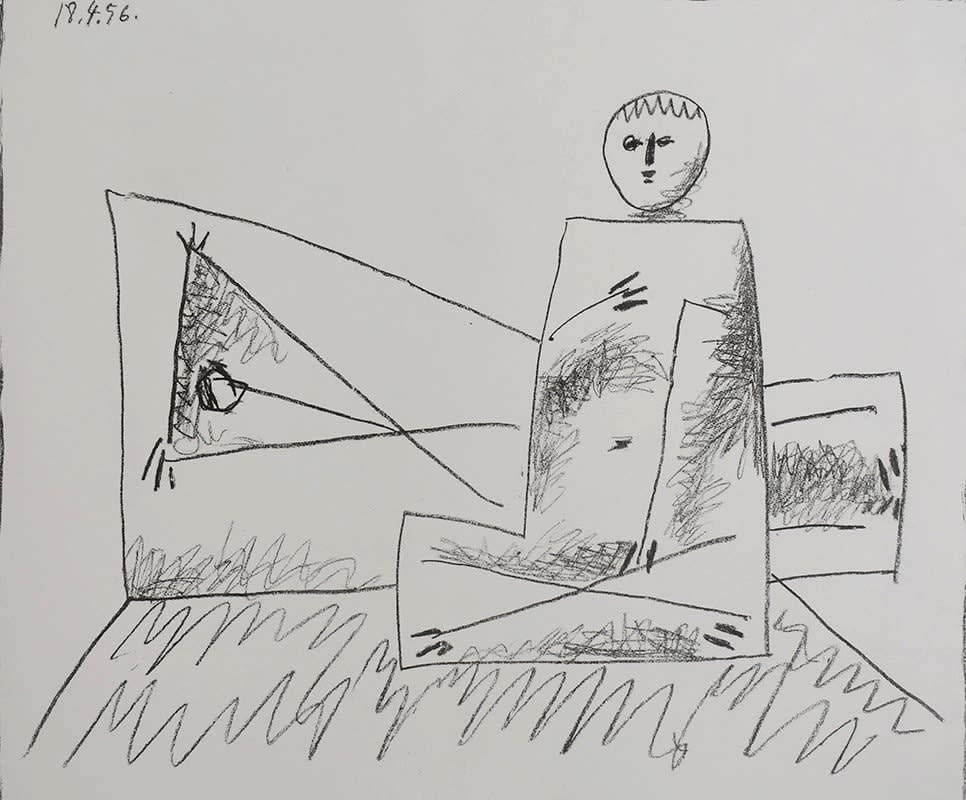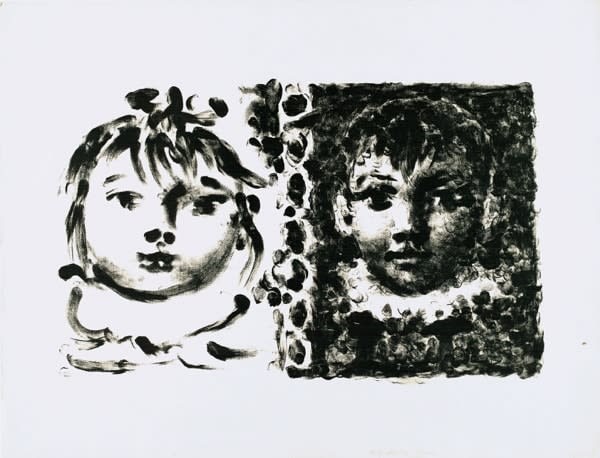
Pablo Picasso
50 x 66 cm
In Reclining Man and Crouching Woman (1956), Pablo Picasso revisits one of the most defining visual languages of modern art—Cubism—while simultaneously pushing it into new expressive territory. The composition, executed in bold yet deceptively simple charcoal lines, reduces human figures to geometric forms: rectangles, triangles, and circles. The reclining figure stretches across the page in angular abstraction, its eye set within a triangular plane, while the crouching companion is rendered as a series of stacked, squared forms crowned with a round, mask-like head.
Here, Picasso distills the human body into its most elemental geometry, a hallmark of Cubist thought, yet his approach in this work feels freer and more playful than in his early analytic Cubism of 1907–1914. The reductive lines recall the lessons of Cézanne, whose vision of nature as cones, spheres, and cylinders first inspired Picasso and Braque to deconstruct reality into fractured perspectives. At the same time, the work echoes the bold simplifications of African art and Iberian sculpture—sources Picasso famously drew upon in the birth of Cubism with Les Demoiselles d’Avignon (1907).
Unlike the dense, faceted planes of his early Cubist paintings, this drawing is airy and direct. It speaks to Picasso’s lifelong ability to reinvent Cubism, using it not as a fixed style but as a living, evolving language. By the mid-1950s, his experiments often combined the structural rigor of Cubist form with the spontaneity of drawing, producing works that were at once analytical and lyrical.
The interplay between the reclining man and crouching woman is also significant. Their forms, while abstracted, remain recognizably human, emphasizing Picasso’s ongoing dialogue between figuration and abstraction. The flattened planes and linear reduction create a tension between depth and surface, presence and absence, echoing Cubism’s original challenge to the Western tradition of illusionistic perspective.
Reclining Man and Crouching Woman thus encapsulates Picasso’s lifelong exploration of Cubism as more than a movement: for him, it was a mode of seeing. By paring figures down to their geometric essence, he underscores the idea that art need not imitate reality but can instead reveal its structure, rhythm, and energy. In this 1956 work, the clarity of line and economy of form demonstrate Picasso’s mastery of Cubism as an open-ended visual philosophy—one that remained central to his practice decades after its revolutionary beginnings.
For more information or to buy Reclining Man and Crouching Woman (1956) by Pablo Picasso, contact our galleries using the form below.-
 Pablo PicassoLe Corsage à Carreaux, 1949
Pablo PicassoLe Corsage à Carreaux, 1949 -
 Pablo PicassoGrand Maternite, 1963
Pablo PicassoGrand Maternite, 1963 -
 Pablo PicassoFrançoise Sur Fond Gris, 1950
Pablo PicassoFrançoise Sur Fond Gris, 1950 -
 Pablo PicassoJacqueline Profile to the Right, 1958
Pablo PicassoJacqueline Profile to the Right, 1958 -
 Pablo PicassoLes Demoiselles d'Avignon, 1953
Pablo PicassoLes Demoiselles d'Avignon, 1953 -
 Pablo PicassoBuste au fond étoilé (Bust with Star Background), 1949
Pablo PicassoBuste au fond étoilé (Bust with Star Background), 1949 -
 Pablo PicassoJeu De La Cape (Bloch 1015), 1961
Pablo PicassoJeu De La Cape (Bloch 1015), 1961 -
 Pablo PicassoTete De Femme Fond Noir, 1946
Pablo PicassoTete De Femme Fond Noir, 1946 -
 Pablo PicassoBuste de Femme au Corsage Blanc (Jacqueline de Profil), 1957
Pablo PicassoBuste de Femme au Corsage Blanc (Jacqueline de Profil), 1957 -
 Pablo PicassoThe Little Artist (Draughtsman) | Le petit dessinateur, 1954
Pablo PicassoThe Little Artist (Draughtsman) | Le petit dessinateur, 1954 -
 Pablo PicassoFemme à L'Italienne d'après le tableau de Victor Orsel (Bloch 740), 1953
Pablo PicassoFemme à L'Italienne d'après le tableau de Victor Orsel (Bloch 740), 1953 -
 Pablo PicassoGrand Nature Mort au Compotier, 1947
Pablo PicassoGrand Nature Mort au Compotier, 1947 -
 Pablo PicassoAfter The Embrace, 1901
Pablo PicassoAfter The Embrace, 1901 -
 Pablo PicassoProfil de Femme
Pablo PicassoProfil de Femme -
 Pablo PicassoProfil au fond noir, 1947
Pablo PicassoProfil au fond noir, 1947 -
 Pablo PicassoRonde de la Jeunesse, 1961
Pablo PicassoRonde de la Jeunesse, 1961 -
 Pablo PicassoFemme à la Robe
Pablo PicassoFemme à la Robe -
 Pablo PicassoJacqueline with Roses, 1956
Pablo PicassoJacqueline with Roses, 1956 -
 Pablo PicassoPaloma et Claude, 1950
Pablo PicassoPaloma et Claude, 1950 -
 Pablo PicassoBuste, 1957
Pablo PicassoBuste, 1957 -
 Pablo PicassoPortrait de Femme II, 1955
Pablo PicassoPortrait de Femme II, 1955 -
 Pablo PicassoTête de Jeune Fille – Portrait de Françoise, 1949
Pablo PicassoTête de Jeune Fille – Portrait de Françoise, 1949 -
 Pablo PicassoJeunesse, 1950
Pablo PicassoJeunesse, 1950
Join our mailing list
* denotes required fields
We will process the personal data you have supplied in accordance with our privacy policy (available on request). You can unsubscribe or change your preferences at any time by clicking the link in our emails.
This website uses cookies
This site uses cookies to help make it more useful to you. Find out more about cookies.






















